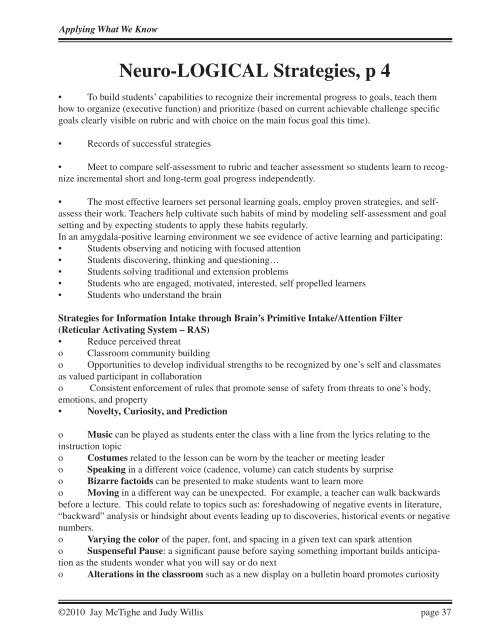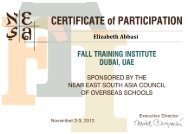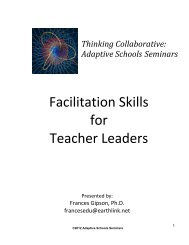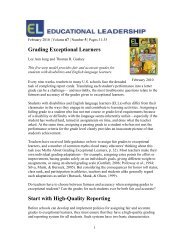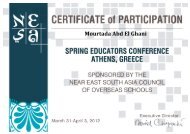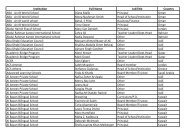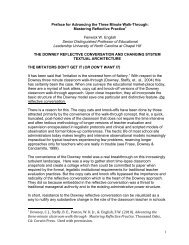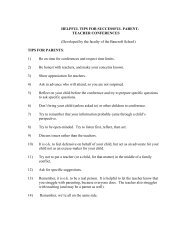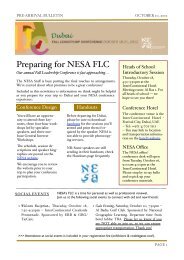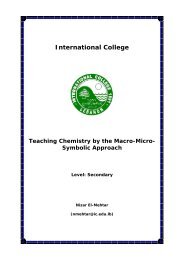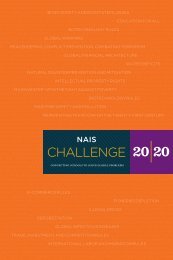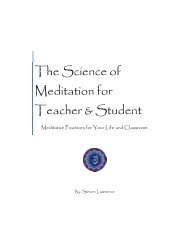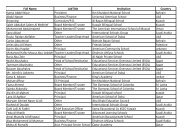Joint Presentation with Judy Willis - NESA
Joint Presentation with Judy Willis - NESA
Joint Presentation with Judy Willis - NESA
You also want an ePaper? Increase the reach of your titles
YUMPU automatically turns print PDFs into web optimized ePapers that Google loves.
Applying What We Know<br />
Neuro-LOGICAL Strategies, p 4<br />
• To build students’ capabilities to recognize their incremental progress to goals, teach them<br />
how to organize (executive function) and prioritize (based on current achievable challenge specific<br />
goals clearly visible on rubric and <strong>with</strong> choice on the main focus goal this time).<br />
• Records of successful strategies<br />
• Meet to compare self-assessment to rubric and teacher assessment so students learn to recognize<br />
incremental short and long-term goal progress independently.<br />
• The most effective learners set personal learning goals, employ proven strategies, and selfassess<br />
their work. Teachers help cultivate such habits of mind by modeling self-assessment and goal<br />
setting and by expecting students to apply these habits regularly.<br />
In an amygdala-positive learning environment we see evidence of active learning and participating:<br />
• Students observing and noticing <strong>with</strong> focused attention<br />
• Students discovering, thinking and questioning…<br />
• Students solving traditional and extension problems<br />
• Students who are engaged, motivated, interested, self propelled learners<br />
• Students who understand the brain<br />
Strategies for Information Intake through Brain’s Primitive Intake/Attention Filter<br />
(Reticular Activating System – RAS)<br />
• Reduce perceived threat<br />
o Classroom community building<br />
o Opportunities to develop individual strengths to be recognized by one’s self and classmates<br />
as valued participant in collaboration<br />
o Consistent enforcement of rules that promote sense of safety from threats to one’s body,<br />
emotions, and property<br />
• Novelty, Curiosity, and Prediction<br />
o Music can be played as students enter the class <strong>with</strong> a line from the lyrics relating to the<br />
instruction topic<br />
o Costumes related to the lesson can be worn by the teacher or meeting leader<br />
o Speaking in a different voice (cadence, volume) can catch students by surprise<br />
o Bizarre factoids can be presented to make students want to learn more<br />
o Moving in a different way can be unexpected. For example, a teacher can walk backwards<br />
before a lecture. This could relate to topics such as: foreshadowing of negative events in literature,<br />
“backward” analysis or hindsight about events leading up to discoveries, historical events or negative<br />
numbers.<br />
o Varying the color of the paper, font, and spacing in a given text can spark attention<br />
o Suspenseful Pause: a significant pause before saying something important builds anticipation<br />
as the students wonder what you will say or do next<br />
o Alterations in the classroom such as a new display on a bulletin board promotes curiosity<br />
©2010 Jay McTighe and <strong>Judy</strong> <strong>Willis</strong> page 37


